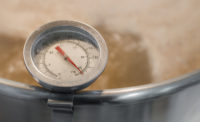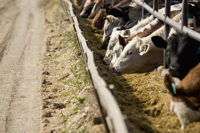To the Point
By Lynn Petrak,
special projects editor
In an era of power and automation, hand-held knives are a testament to the art of meat cutting
There is “cutting edge,” and then there is cutting edge. One is a term commonly used describe the latest advances in technology, while the other refers to the sharp precision of a blade. In today’s meat and poultry plants, both definitions play out in the slaughter and further processing of red meat and poultry: while automated machinery hums and whirs all around the floor, there are remains a small group of trained individuals with a firm grip on cutting instruments, carefully yet deftly doing what has been done for decades.
Certainly, there is a bit of history and proficiency to the fabrication of meat meant for human consumption. But there is also a reality that despite the advent of powered tools, the hand-held knife is essential to nearly every meat and poultry cutting operation.
“People talk about machinery and about things like robotic arms, but nothing can replace the human involvement. Because of certain requirements that customers who are buying meat products have, things have to be hand done,” says David Philgreen, general manager of Kansas City, MO-based knife company ARY Inc.
Bernard Huff, president of Hantover Inc., Kansas City, MO, agrees and says that knives have remained a processing plant mainstay because that type of hand-to-product contact can’t be replaced. “There is an art to using a knife and cutting meat,” he points out.
Another supplier of knives to meat and poultry customers says that hand-held knives remain as reliable and valuable as they are effective in removing meat from things like bone, fat, skin and hair. “There will always be a need for knives,” says Dave Summers, vice president, product development for the Bunzl Processor Division, division of Bunzl Distribution, St. Louis, MO. “Along with powered trimmers come things like maintenance, spare parts and training, with costs associated with it.”
Making the cut
Knives have been around, more or less, since humans began hunting animals and cleaning them for food. In the past century or so, hand-held knives have been a fixture in slaughterhouses, meatpacking plants, butcher shops and supermarket meat departments alike.
These days, in an era of demand for increased speeds and reduced labor resources, knives are still used for a variety of purposes for beef, pork, lamb, veal, chicken, turkey and seafood. On the kill floor, for instance, sticking knives are used to cut the throat of cattle after they have been stunned. As further processing continues off the slaughter area, employees take hand-held knives to carcasses to remove unwanted material like skin, hide and bone and, a few steps later in the process, retrieve as much usable, high-quality meat as possible. Hand-held knives are also used to cut boneless meat portions.
Choosing the right knife for a certain application is a decision with important ramifications. From an economic standpoint, the proper knife usage means the difference between viable trimmings and waste. Controlled yields, as any processor can attest, have a direct bearing on profit margins.
From a functional perspective, hand-held knives are typically specialized for certain functions like skinning or deboning and are sometimes customized for users. Within those functions, meanwhile, some knives are more effective than others: what works to remove hides from cattle, for instance, likely will not work to remove a scapula from a turkey.
Because of the scope of requirements for hand-held knives, many knife manufacturers and distributors offer a broad range of cutting instruments for meat and poultry processors. ARY, for instance, started its business in 1980 with a series of 10 beechnut wood-handled knives. “Now, we have more than two hundred designs for beef, pork and poultry, and we have more than fifteen handles in a variety of materials and textures,” reports Philgreen, adding that the Comfort Grip series is designed for meat and poultry settings.
Bunzl and Hantover, meanwhile, offer hundreds of knife styles in their catalogs from knife manufacturers such as Swiss Army, Dexter-Russell, ARY, and Chicago Cutlery, among others. Summers agrees that the choice of a knife depends on a plant’s particular operations and preferences. “There are several knife styles that have a basic intended use,” he notes.
That said, some essential knives are more likely than others to be mainstays in meat and poultry processing plants. “Much of it centers on boning knives. The basic six-inch curved flexible boner always will be a basis of the business,” remarks Summers.
Trends spur changes
The knife may be one of man’s oldest tools, but just as people keep reinventing the wheel, knives too are the subject of improvements and changes in design.
Some changes are driven by emerging issues within the meat and poultry sector. Concerns over employee problems like carpal tunnel syndrome, for example, have led to a greater focus on ergonomics across many areas of processing plants, including knives.
As a result, many new or improved models of knives over the past decade have centered on ergonomic features. “Ergonomics often relates to handle design, from the materials of which they are made and the angle of the handles,” relays Summers.
Philgreen agrees, citing the 15 handle designs now available from ARY. “A lot of it is about ergonomics. If you can imagine an employee holding a knife eight hours a day in motion, and that is the biggest part of your job, we have to create a knife they are satisfied with,” he says.
Many, if not most, of the latest hand-held knives to hit the marketplace have ergonomic features. ARY, for example, recently introduced a new 8-inch heading knife for pork applications. “That is a specialized handle that is designed to address the buildup of protein that we find in pork plants,” explains Philgreen.
Likewise, Cincinnati-based Best and Donovan has addressed ergonomic concerns with its hand-held trimming devices used to skin, de-fat and trim products. “It is advantageous ergonomically. It is designed to control product yield while reducing carpal tunnel syndrome,” says vice president Brad Andre of the company’s S-1008 hand-held air knives used for purposes ranging from patching pork belies to removing poultry breast skin.
Beyond ergonomics, there are other concerns about worker health and safety. To that end, knives are increasingly designed with a host of safety features. “All along the way there have been issues with safety. It’s why you see guards, finger loops and other things tied to safety,” notes Summers.
ARY, too, has made recent upgrades related to employee safety, including a re-designed 6-inch measuring knife used to measure fat and hence determine yield on cuts. “It is a safety hazard because employees will put this six-inch tool in their pocket and a lot of them who use measuring knives will sharpen the rule when they aren’t supposed to,” explains Philgreen. “Our idea was to make it into a knife, and it has been very well received.” Because the measuring knife now includes a two-inch sharpened edge, the instrument is considered a knife and is handled accordingly.
Because safety is, to borrow a relevant phrase, a double-edged sword, safety features for hand-held knives also are linked with sanitation. According to Summers, Bunzl is heeding more requests for knife designs and knife accessories that help prevent cross-contamination. “Cleaning and sterilization is big right now,” he says.
As such, Bunzl is now offering a plastic scabbard, a storage pouch used by boning line professionals or butchers on their belts. “It is a two-piece design, compared to most storage pouches which are one-piece. In this, the front can be easily removed for cleaning.” In addition, the scabbards can be color coded to easily determine where they are to be used in a facility.
Color coding extends to knife handles as well, to ensure help safety. In its catalog, Bunzl sells a line of knives with various colored handles for easy identification. ARY, for its part, has developed a series of color-coded hand-held knives. “They are built to ensure that every employee cutting meat is using the right knife,” says Philgreen.
In addition to issues like ergonomics and safety, the sheer scope of product offerings generated by modern meat and poultry operations also is impacting design. As more processors diversify into value-added products, they look for different knives that meet their needs. “There are a lot of changing demands on the plants as far as demand from their customers. One example is fajita meat,” says Philgreen, adding that a certain type of knife is used to most effectively cut boneless meat for small fajita pieces that are sold case ready to supermarkets and foodservice operations.
Sharpening their skills
As manufacturers make changes to the designs of hand-held knives, they and other companies also emphasize knife sharpening as well. “We spend a lot of time in the knife room and on the floor,” reports Philgreen, adding that ARY offers a tester for sharpness to determine the amount of force used when cutting.
According to Philgreen, ARY also has developed polished steel sharpeners. “Polished steel is a technology that aligns the edges of the blade much faster and easier.”
Summers agrees that sharpness is critical when using hand-held knifes. “Probably the most important thing today is sharpening and sharpening programs — the way knives are designed so they can be sharpened is a huge deal today,” he remarks, adding that the degree of sharpness affects knives in several important ways. “It relates to knife life. You get the most usable knife life possible and workers get higher yields and are more productive with knives with sharp edges.”
To that end, technology has been applied to create sharpeners that increase the usage, efficacy and safety of knives. Several companies offer knife sharpening services and equipment. Bunzl, for instance, sells bench-top sharpeners, hand-held sharpeners and various sharpening stones, according to Summers.
Another provider of sharpening tools and equipment is Chicago-based Cozzini Group. Among a range of items for both smaller and large meat processors, Cozzini offers a PRIMEdge HE7 Honer/Edger for high-volume knife users that includes a built-in angle compensator, and a PRIMEdge HES-2 Ergo Steel for larger meat processing operations that can be used to sharpen large and small knives in a matter of seconds. True-Hone Corporation, Ocala, FL, also offers sharpeners for hand-held knives, such as its stainless steel True Hone knife sharpener that can grind both bevels simultaneously, the True Hone HG3 Hollow Grinder that taper grinds both sides of a knife simultaneously and that features a full-flow coolant system and the True Hone Crossteel that realigns knife edges for razor sharpness and that can be mounted on the processing line.
Still, sharpening is only one way to ensure that a hand-held knife is used properly and to the best possible effect. For one, training is essential for those using hand-held knives on the line. Inspection and maintenance are pivotal as well. “It’s not just how sharp it can be when it leaves the knife room. It’s how well it can be maintained once it leaves the knife room,” points out Summers. NP
Knife manufacturers and suppliers featured in this article include:
Ary Inc., phone (800) 821-7849, fax (816) 761-0055, or visit www.aryvacmaster.com
Best & Donovan, (800) 553-2378, fax (513) 791-0925, info@bestanddonovan.com, or visit www.bestanddonovan.com
Bunzl Distribution, phone (888) 997-5959, fax (314) 997-0247, or visit www.bunzldistribution.com
Cozzini Inc., phone (800) 227-4447, fax (773) 478-8689, sales@cozzini.com, or visit www.cozzini.com
Hantover Inc., phone (800) 821-2227, fax (816) 761-0044, e-mail contactus@hantover.com, or visit www.hantover.com

